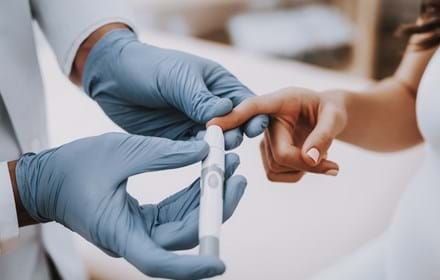
The long Covid impact on diabetes research beyond the pandemic
The Diabetes UK Professional Conference is underway. Read Day Three of DRWF Research Manager Dr Eleanor Kennedy’s blog reports from the event.
It is the third day of the Diabetes UK Professional Conference and, even though it is online, I am still in a quandary about what sessions to attend. I jump about from one to the other and back again to try to cover what I can.
However, one symposium catches my eye: Update on pens, pumps, sensors and closed loop devices. This kicks off with Dr Emma Willmott talking about smart pens and insulin pumps.
Dr Willmott begins by reminding us of the changes that have happened in care during the last few months as the Covid-19 pandemic took hold. The majority of diabetes services are now working remotely, and she feels they will continue to do so. Paper diaries may no longer have a role in this new environment except for the minority of people who still find them useful.
The challenges in this brave new world therefore are to ensure that healthcare professionals have their patients’ glucose and insulin data available to review in order to support improvements in time in range.
Missed boluses are a real trial for people living with diabetes and pens with a memory function are a preferred option, with a review of eight studies noting increased confidence not to miss injections coupled to increased confidence in self-management. These so-called smart pens could overcome the need to log insulin doses manually, provide glucose and insulin data on the same platform and support a reduction in the number of missed insulin doses.
Switching focus to insulin pumps, Dr Willmott noted that, in 2008, the National Institute for Health and Care Excellence (NICE) recommended insulin pumps for adults and children over the age of 12 with type 1 diabetes provided that HbA1c levels remained high (i.e. at 8.5% (69 mmol/mol) or above) on multiple daily injection therapy despite a high level of care or attempts to achieve target HbA1c levels with multiple daily injections of insulin resulting in disabling, and very strictly defined, hypoglycaemia (low blood sugar levels).
Pros and cons of insulin pumps
Insulin pumps bring with them a wealth of benefits – they remove the need for multiple injections, there is an in-built bolus calculator making it easy to bolus. Moreover, more precise insulin delivery can be tailored to individual needs e.g., smaller doses, personalised basal rate profiles and temporary basal rates. This all combines to lead to better glucose control and less hypoglycaemia.
However, there are, according to Dr Willmott, definite down sides to insulin pump therapy. The device needs to be worn 24/7 apart from, for example, showering. It is a constant visible reminder of diabetes and there are concerns about wearing them whilst asleep or during intimacy or when exercising. Half of people using an insulin pump will experience kinking, or blocking, of the infusion set at some time and, of course, it only contains rapid acting insulin so there is a risk of diabetic ketoacidosis (DKA) if insulin delivery is disrupted.
In addition, there are barriers to starting pump therapy. There are perceptions about who is best suited to pump therapy - the REPOSE Study by researchers at the University of Sheffield, demonstrated that healthcare professionals are actually not that good at predicating who will do well on insulin pump therapy. In addition, just 18% for the most deprived groups discuss technology at their clinical appointments compared to 46% of the least deprived.
The JDRF Pathway to choice document recommends that people with type 1 diabetes have more time with their specialist healthcare professionals at appointments, that healthcare professionals should receive mandatory training on type 1 diabetes technology and that clinical commissioning groups should do more to reach people with type 1 diabetes from lower socio-economic groups.
Major improvements in continuous glucose monitoring (CGM) technology
Dr Lalantha Leelarathna then discussed continuous glucose monitoring and flash glucose monitoring. Elegantly walking his online audience though a number of trial results including the FLASH-UK, MILLENIALS, CITY, WISDM and CORRIDA studies, he concluded that there have been major improvements in sensor technology moving towards a reduced size and an improved accuracy. Multiple studies now show an improvement in glycaemia with better time in range and a reduced hypoglycaemia burden with the use of glucose sensors. He argued that time in range is a more meaningful measurement that HbA1c and will likely be linked to fewer long-term complications of diabetes but that further studies are required in this area.
Finally, Professor Roman Hovorka spoke about the closed loop, “artificial pancreas” system. His action plan is to encourage the embracing of close loop technologies, to address clinical inertia and postcode lotteries affecting access including procurement, to create training resources, including online ones, and to support research into diabetes technology and its impact on diabetes outcomes.
Also on this third day of the conference is a session with the less than snappy title of Joint Diabetes UK, ABCD, Renal Association and Kidney Research UK symposium: Managing diabetes and kidney disease.
Why is it important that so many organisations have come together to discuss kidney disease?
In the last few years there has been a wealth of new trial data on some, but not all, of the pharmacological therapies for type 2 diabetes, with particular reference to insulin and the newer classes of drug, the SGLT-2 inhibitors and the GLP-1 receptor agonists. And their effects on people with existing kidney disease have been of huge interest to the field with some unexpected results being observed.
This wide-ranging symposium covered not just the management of hyperglycaemia (high blood glucose levels) in the setting of kidney disease, in addition to information on the management of lipids and hypertension in people with diabetes-related kidney disease and the management of acute kidney injury in people with diabetes.
Acute kidney injury (AKI) is a common complication in people with diabetes. Healthcare professionals need to be aware of this issue and people with diabetes need to be educated and informed, in order to reduce the potential harm associated with AKI.
Impact of Covid-19
This was where everything came into focus for all of us living through the Covid-19 pandemic. Chronic kidney disease (CKD) is associated with an increased risk in relation to Covid-19. Patients with CKD contribute greatly to the total number of patients with Covid-19 infection admitted to hospital. Moreover, patients with CKD have a poorer outcome from Covid-19 infection and the mortality rate of those on dialysis who develop Covid-19 infection is in the order of 20%. Covid-19 can be complicated by AKI, which is also associated with a poorer outcome. In the first wave of the pandemic, 27% of patients in intensive care units with Covid-19 received renal replacement therapy whilst in the second wave this number stood significantly reduced at 14% as our understanding of the coronavirus infection rose.
As I log off for the evening, I wonder how long Covid-19 will feature in our conferences. Is it here to stay as a permanent fixture? Will there always be presentations on it? There is still so much that we do not know and so much research that needs to be done. Or, as the population’s vaccination rates increase, will it fade in our collective memories to be the year when in the future we just shrug our shoulders and say “2020! What a year that was, huh?!”.
Read Lockdown guidance for staying home and safe for people living with diabetes during Covid-19 pandemic
Read How people with diabetes could become more ill if diagnosed with Covid-19
DRWF operations during the Covid-19 health crisis
The DRWF team is working remotely. Covid-19 guidance, particularly where it aligns or impacts with diabetes guidance, is shared as quickly as possible through the DRWF website and social media channels with the aim of making it as easy to understand as possible and a reliable source of latest news.
Further reports to follow – visit DRWF news page
Follow Dr Eleanor Kennedy on Twitter: @DRWFEleanor
Support DRWF by making a donation here
Find out more about DRWF-funded research here
Find out more about DRWF fundraising here
For latest update follow DRWF on Facebook, Instagram and Twitter
To receive the charity’s latest bulletins as they become available, please sign up here
Read DRWF diabetes information leaflets here
Join the Diabetes Wellness Network here
Recent News


